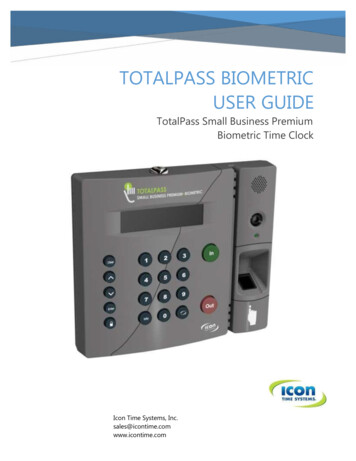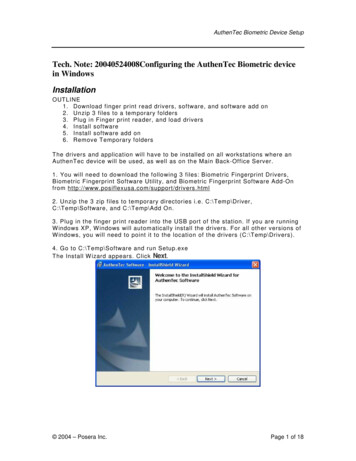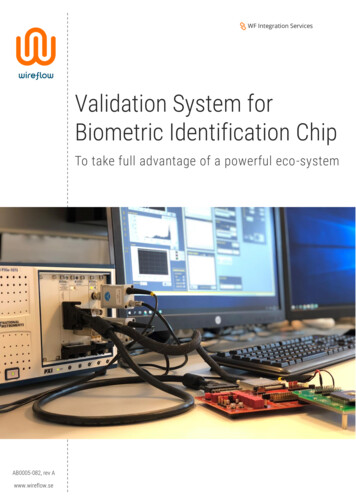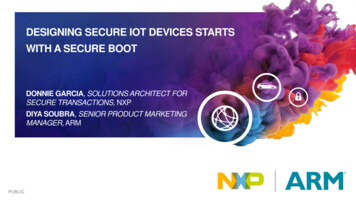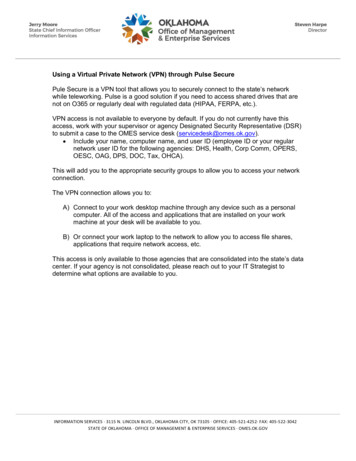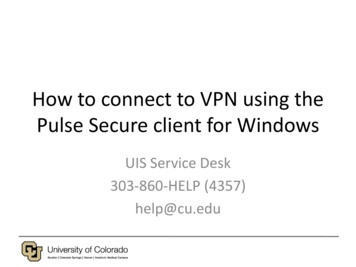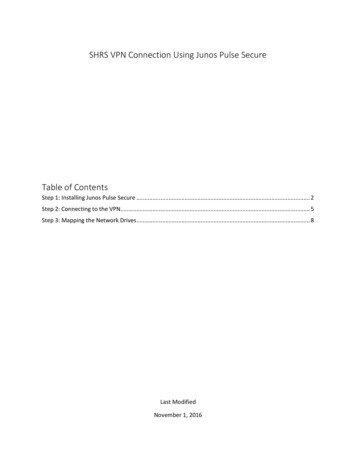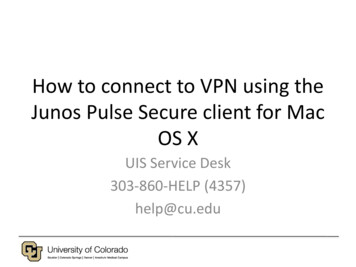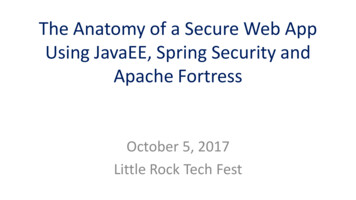
Transcription
Ghostshell: Secure Biometric Authentication usingIntegrity-based Homomorphic EvaluationsJung Hee Cheon1 , HeeWon Chung1 , Myungsun Kim2 , and Kang-Won Lee31Department of Mathematical Sciences, Seoul National University{jhcheon,runghyun}@snu.ac.kr2Department of Information Security, The University of Suwonmsunkim@suwon.ac.kr3Network IT Convergence, Corporate R&D Center, SK telecomkangwon@sk.comAbstract. Biometric authentication methods are gaining popularity due to their convenience. Foran authentication without relying on trusted hardwares, biometrics or their hashed values shouldbe stored in the server. Storing biometrics in the clear or in an encrypted form, however, raisesa grave concern about biometric theft through hacking or man-in-the middle attack. Unlike IDand password, once lost biometrics cannot practically be replaced. Encryption can be a tool forprotecting them from theft, but encrypted biometrics should be recovered for comparison.In this work, we propose a secure biometric authentication scheme, named Ghostshell, in which anencrypted template is stored in the server and then compared with an encrypted attempt withoutdecryption. The decryption key is stored only in a user’s device and so biometrics can be kept secreteven against a compromised server. Our solution relies on a somewhat homomorphic encryption(SHE) and a message authentication code (MAC). Because known techniques for SHE is computationally expensive, we develop a more practical scheme by devising a significantly efficient matchingfunction exploiting SIMD operations and a one-time MAC chosen for efficient homomorphic evaluations (of multiplication depth 2). When applied to Hamming distance matching on 2400-bit irises,our implementation shows that the computation time is approximately 0.47 and 0.1 seconds forthe server and the user, respectively.Keywords: Biometric authentication, Homomorphic encryption, MAC
Table of Contents1 Introduction . . . . . . . . . . . . . . . . . . . . . . . . . . . . . . . . . . . . . . . . . . . . . . . . . . . . . . . . . . . . . . . .2 Models and Settings . . . . . . . . . . . . . . . . . . . . . . . . . . . . . . . . . . . . . . . . . . . . . . . . . . . . . . . . .2.1 System Model and Participants . . . . . . . . . . . . . . . . . . . . . . . . . . . . . . . . . . . . . . . . . . .2.2 Threat Model . . . . . . . . . . . . . . . . . . . . . . . . . . . . . . . . . . . . . . . . . . . . . . . . . . . . . . . . . .2.3 Security Model . . . . . . . . . . . . . . . . . . . . . . . . . . . . . . . . . . . . . . . . . . . . . . . . . . . . . . . . .3 A Strawman Proposal . . . . . . . . . . . . . . . . . . . . . . . . . . . . . . . . . . . . . . . . . . . . . . . . . . . . . . .3.1 A Simple, but Insecure Design . . . . . . . . . . . . . . . . . . . . . . . . . . . . . . . . . . . . . . . . . . . .3.2 Challenges and Solution Sketch . . . . . . . . . . . . . . . . . . . . . . . . . . . . . . . . . . . . . . . . . . .4 Upgrading the Strawman Proposal . . . . . . . . . . . . . . . . . . . . . . . . . . . . . . . . . . . . . . . . . . . .4.1 Cryptographic Background . . . . . . . . . . . . . . . . . . . . . . . . . . . . . . . . . . . . . . . . . . . . . . .4.2 A Woodenman Protocol . . . . . . . . . . . . . . . . . . . . . . . . . . . . . . . . . . . . . . . . . . . . . . . . .4.3 An Ironman Protocol . . . . . . . . . . . . . . . . . . . . . . . . . . . . . . . . . . . . . . . . . . . . . . . . . . . .5 Our Biometric Authentication . . . . . . . . . . . . . . . . . . . . . . . . . . . . . . . . . . . . . . . . . . . . . . . .5.1 How Ghostshell Works . . . . . . . . . . . . . . . . . . . . . . . . . . . . . . . . . . . . . . . . . . . . . . . . . . .5.2 Analysis . . . . . . . . . . . . . . . . . . . . . . . . . . . . . . . . . . . . . . . . . . . . . . . . . . . . . . . . . . . . . . .6 Optimizations . . . . . . . . . . . . . . . . . . . . . . . . . . . . . . . . . . . . . . . . . . . . . . . . . . . . . . . . . . . . . .6.1 Speeding-up Computations . . . . . . . . . . . . . . . . . . . . . . . . . . . . . . . . . . . . . . . . . . . . . . .A Practical Variant of the Ironman Protocol . . . . . . . . . . . . . . . . . . . . . . . . . . . . . . . .6.2 Ciphertext Compression . . . . . . . . . . . . . . . . . . . . . . . . . . . . . . . . . . . . . . . . . . . . . . . . .7 Evaluation . . . . . . . . . . . . . . . . . . . . . . . . . . . . . . . . . . . . . . . . . . . . . . . . . . . . . . . . . . . . . . . . .7.1 Implementation . . . . . . . . . . . . . . . . . . . . . . . . . . . . . . . . . . . . . . . . . . . . . . . . . . . . . . . . .7.2 Micro Experiments . . . . . . . . . . . . . . . . . . . . . . . . . . . . . . . . . . . . . . . . . . . . . . . . . . . . . .8 Related Work . . . . . . . . . . . . . . . . . . . . . . . . . . . . . . . . . . . . . . . . . . . . . . . . . . . . . . . . . . . . . . .9 Summary . . . . . . . . . . . . . . . . . . . . . . . . . . . . . . . . . . . . . . . . . . . . . . . . . . . . . . . . . . . . . . . . . .3455566677913161617171818192020212324
1IntroductionBiometric authentications are seeing greater industrial deployment, including mobile paymentsystems such as Apple Pay and Alipay. Compared to other types of authentication (e.g., passwords and secure tokens), biometrics cannot be lost or forgotten and, in particular, users beingauthenticated should be present at the time and place of authentication. On the other hand,privacy loss in biometric authentication systems is substantially more serious than in other authentication systems because biometrics are difficult to be replaced once stolen. Most recently,hackers have stolen a total of 5.6 million fingerprint records from the U.S. government [2].The stolen biometric databases could be used to fool certain systems. Thus, it is imperative todevelop a solution with a far stronger protection of such data.Encrypted DB· · · , (U, x̄ ), · · ·xAuthenticationServer(AS)UUserb {accept, reject}Fig. 1. Our authentication framework.Cryptographic protection. We investigate a secure biometric authentication method withoutrelying on trusted hardware. Our approach is to encrypt and store a users biometric template ina server as in Figure 1. During authentication, the user sends an encrypted biometric attempt tothe server, which authenticates by comparing two ciphertexts without decryption. Comparingciphertexts without decryption is the main security property that our proposed scheme provides.One may consider a trivial approach to store only hashed templates in the server through aone-way hash function such as SHA3 [31]. However, biometric inputs are not exactly the sameevery time they are captured due to scanning noise and so cannot have the same hashed values.Indeed, we have no hash function to map two slightly different inputs to the same value.Our solution. We employ a somewhat homomorphic encryption (SHE) that evaluates a polynomial of certain degree on encrypted data without decryption [18, 35]. Upon an encryptedtemplate and an encrypted attempt, the server performs a matching algorithm without decryption, which outputs an encrypted matching result. Hence, the server comes to learn thematching result by asking its decryption to the user.It is crucial to prevent an arbitrary manipulation of a result during the decryption process ofa user corrupted by an attacker. To achieve this, we attach a tag to the encrypted result, whichis decrypted to the message authentication code (MAC) of the result. It is possible by virtue ofthe homomorphic properties of SHE, but which is hard for ordinary encryption functions.This approach provides a sort of decryption oracle, which clearly could result in a securityweakness, allowing a malicious server to recover some biometrics. Note that SHE is secure onlyagainst chosen plaintext attacks (CPAs), not against chosen ciphertext attacks (CCAs). In orderto prevent such an undesirable situation of obtaining decryption oracle, we further introduce amethod to enclose the tag using a one-way function with discrete logarithm settings so that thesever can learn only the enclosed value of the tag. It prevents a misuse of the decryption keythrough receiving a decryption query of its ciphertext.3
Optimization. Computing Hamming distance between two biometrics of n bits in length requires at least n multiplications. Considering slow multiplication time of two ciphertexts, iteasily exceeds a tolerance range of practical systems, e.g., it takes at least 30 seconds for acomparison of two irises of 2400 bits when the multiplication takes 14 milliseconds per bit as inour implementation.We utilize the packing techniques proposed in [38] to implement a homomorphic matchingalgorithm performing N multiplications of ciphertexts at a time where an N -bit plaintext ispacked into one ciphertext. We mean by “homomorphic” that the matching algorithm runs onciphertexts, and a multiplication of two ciphertexts indicates an encryption of an N -bit outputwhich is a bitwise multiplication of two plaintexts. Further, we use single-instruction multipledata (SIMD) techniques on SHE ciphertexts [38]. This allows us to compute the sum of the N -bitoutput only using log N additions. Recall that addition are far efficient than multiplication. Tosum up, these techniques help the homomorphic matching algorithm to run approximately Ntimes faster than a naı̈ve one. To this end, we find an SHE system parameter with which anSHE scheme instantiated encrypts N 630 bits into a ciphertext at a time.When we combine our matching algorithm with MAC, however, we meet with another obstacle from the performance’s point of view. An ordinary MAC function has a large multiplicationdegree, and so is considerably time-consuming to evaluate the MAC function homomorphically.However carefully looking into our authentication process, the MAC tag is verified immediatelyafter generated and the server is the generator and the verifier of the MAC tag. This avoids thenecessity of the server sharing a long-term MAC secret key. Thus, we observed that it is enoughto use a lightweight one-time MAC scheme. We employ a variant of one-time MAC (OTM) proposed by Simmons [37], requiring only one multiplication and one addition. In turn, we againmodify our homomorphic matching algorithm so as to accommodate the OTM scheme.Despite the speedups of computation, the large size of SHE ciphertexts still causes long delaysin transmission. This problem is overcome by applying a ciphertext-compression technique byCoron et al. [15]. Thus, we reduce the size of SHE ciphertext by half. By integrating those threetechniques, we obtain a practical biometric authentication scheme, named Ghostshell.When applying our optimizations over Brakerski et al.’s scheme [7], our implementationshows that encrypting a 2400-bit iris code only requires 16.2 milliseconds. The ciphertext sizeof our SHE scheme for a 2400-bit plaintext iris is approximately 40.1 KB while the bit-by-bitencryption requires 98.3 MB for the same iris. The server’s matching process runs in approximately 0.46 second. Majority of the time is spent in computing the Hamming distance (0.45seconds).Organization. Our system architecture and participants are described in Section 2. We firstattempt to construct a simple, but insecure protocol in Section 3. In Section 4, then we renovateour basic protocol to provide privacy and integrity of biometrics. Our authentication system isprovided in Section 5. Section 6 shows our optimizations for practical deployment to the realworld applications. Section 7 provides our implementation and experimental results. Finally, wediscuss closely related works in Section 8.2Models and SettingsIn this section, we present the system architecture for this work. Throughout this paper, ourproposal works in this framework.4
2.1System Model and ParticipantsOur system is designed for an authentication server, or server for short, to authenticate eachuser using the 1 : 1 method. Our system consists of two participants, namely, a user and anauthentication server (AS).The user, denoted by U, has a binary feature x properly extracted from his biometric source.The server, denoted by S, has rich computational resources and storage; thus, it can evaluatearbitrary functions on SHE ciphertexts but cannot decrypt ciphertexts evaluated by itself as wellas ciphertexts given by the user. To enrich the applicability of our system, we may introduce athird entity, called a service provider (SP), that communicates with the two other participants.For example, telecoms could use our authentication platform for bridging between mobile usersand service providers (e.g., Amazon and Bank of America).2.2Threat ModelOur security goals are two-fold. The first is that no AS (or SP) should be able to learn anythingabout the biometric data contributed by users beyond what is revealed by the final result ofthe execution. In the case where the AS and some users collude, they should not learn anythingabout the biometrics from other honest users beyond the final result and its implications. Thesecond goal is that an impostor should not be able to fool the AS into believing that he isauthentic; see reference [34] for the detailed threats.In this work, we focus on the following attacks to ensure security for authentication andprivacy for the user’s biometrics.– Threat #1. Participants on the user side of our system are well motivated to be maliciousand thus make an honest AS output an accept at the conclusion of the user authentication.Further, they may collude with arbitrary other users to attempt to break the security of thesystem.– Threat #2. Some participants on the server side in our system are also motivated to behavemaliciously and thus learn information about private biometrics from honest users becausethe data can potentially be sold to an attacker, e.g., passport forgers. A typical example isa biometric database administrator corrupted by an attacker.However, o
encrypted template is stored in the server and then compared with an encrypted attempt without decryption. The decryption key is stored only in a user’s device and so biometrics can be kept secret even against a compromised server. Our solution relies on a somewhat homomorphic encryption (SHE) and a message authentication code (MAC). Because known techniques for SHE is computa-tionally .
